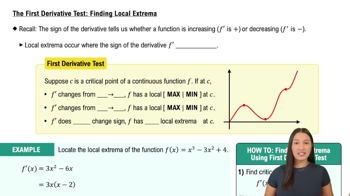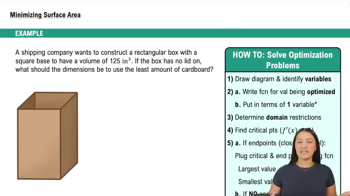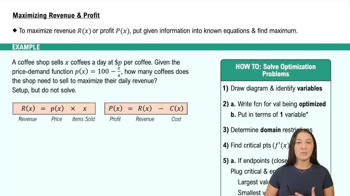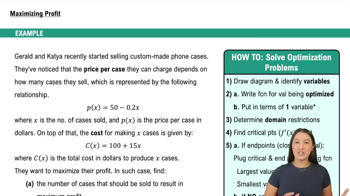Table of contents
- 0. Functions7h 52m
- Introduction to Functions16m
- Piecewise Functions10m
- Properties of Functions9m
- Common Functions1h 8m
- Transformations5m
- Combining Functions27m
- Exponent rules32m
- Exponential Functions28m
- Logarithmic Functions24m
- Properties of Logarithms34m
- Exponential & Logarithmic Equations35m
- Introduction to Trigonometric Functions38m
- Graphs of Trigonometric Functions44m
- Trigonometric Identities47m
- Inverse Trigonometric Functions48m
- 1. Limits and Continuity2h 2m
- 2. Intro to Derivatives1h 33m
- 3. Techniques of Differentiation3h 18m
- 4. Applications of Derivatives2h 38m
- 5. Graphical Applications of Derivatives6h 2m
- 6. Derivatives of Inverse, Exponential, & Logarithmic Functions2h 37m
- 7. Antiderivatives & Indefinite Integrals1h 26m
- 8. Definite Integrals4h 44m
- 9. Graphical Applications of Integrals2h 27m
- 10. Physics Applications of Integrals 2h 22m
5. Graphical Applications of Derivatives
Applied Optimization
Problem 4.5.12
Textbook Question
Maximum-area rectangles Of all rectangles with a fixed perimeter of P, which one has the maximum area? (Give the dimensions in terms of P.)
 Verified step by step guidance
Verified step by step guidance1
Start by expressing the perimeter of the rectangle in terms of its length (l) and width (w). The perimeter P is given by the formula: P = 2l + 2w.
Solve the perimeter equation for one of the variables, say w, in terms of l and P: w = (P/2) - l.
Express the area A of the rectangle in terms of l and w. The area A is given by: A = l * w.
Substitute the expression for w from step 2 into the area formula: A = l * ((P/2) - l).
To find the maximum area, take the derivative of A with respect to l, set it to zero, and solve for l. This will give you the length that maximizes the area. Use the second derivative test to confirm that this value of l gives a maximum area.
 Verified video answer for a similar problem:
Verified video answer for a similar problem:This video solution was recommended by our tutors as helpful for the problem above
Video duration:
4mPlay a video:
Was this helpful?
Key Concepts
Here are the essential concepts you must grasp in order to answer the question correctly.
Perimeter and Area of Rectangles
The perimeter of a rectangle is the total distance around it, calculated as P = 2(l + w), where l is the length and w is the width. The area is given by A = l * w. Understanding the relationship between these two formulas is crucial for determining how to maximize the area while keeping the perimeter constant.
Recommended video:

Estimating the Area Under a Curve Using Left Endpoints
Optimization in Calculus
Optimization involves finding the maximum or minimum values of a function. In this context, we need to maximize the area function A(l) under the constraint of a fixed perimeter. This typically involves using techniques such as taking derivatives and applying critical point analysis to find where the area is maximized.
Recommended video:

Intro to Applied Optimization: Maximizing Area
Critical Points and the First Derivative Test
Critical points occur where the first derivative of a function is zero or undefined. To find the maximum area of the rectangle, we differentiate the area function with respect to one variable, set the derivative to zero, and solve for that variable. The first derivative test helps determine whether these critical points correspond to a maximum or minimum.
Recommended video:

The First Derivative Test: Finding Local Extrema

 1:13m
1:13mWatch next
Master Intro to Applied Optimization: Maximizing Area with a bite sized video explanation from Callie
Start learningRelated Videos
Related Practice








